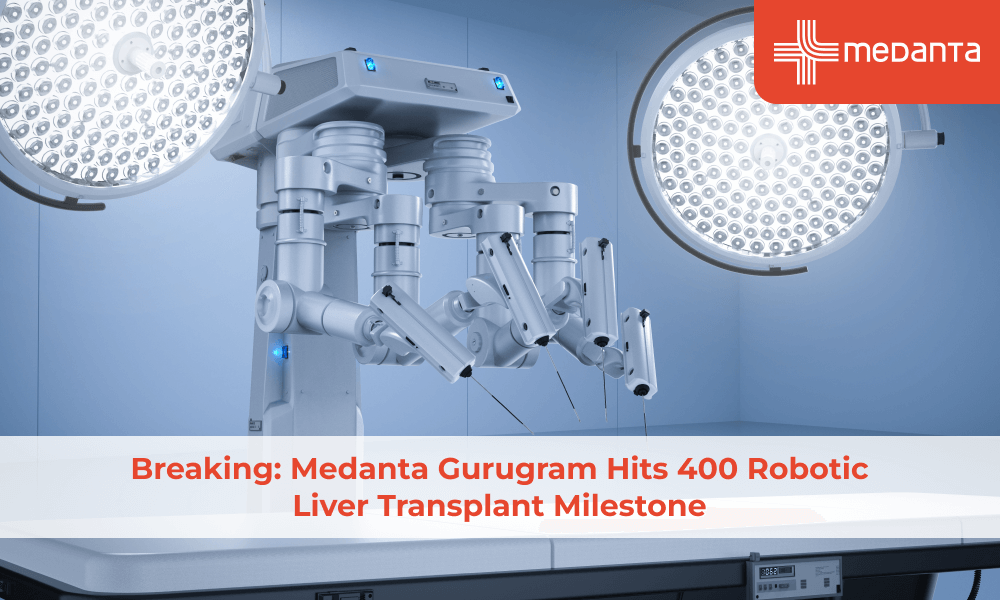Breaking: Medanta Gurugram Hits 400 Robotic Liver Transplant Milestone

TABLE OF CONTENTS
- Surgery marks a national milestone in liver care
- Procedure conducted at Medanta Medicity, Gurugram
- 400th transplant performed using the Da Vinci robotic system
- Who Are the Patients Behind the Milestone?
- How Robotic Surgery Transformed Liver Transplants
- What Experts Say About the Future of Robotic Transplants
- Conclusion
The Department of Liver Transplant at Medanta Gurugram recently reached a remarkable milestone as it completed its 400th successful robotic liver transplant procedure. This achievement represents a significant advancement in liver transplant innovation and positions the hospital as a leader in specialised surgical care. Medanta’s dedicated surgical team has refined the robotic donor hepatectomy technique, consequently improving patient outcomes while reducing recovery times. Additionally, the precision offered by the Da Vinci robotic system has transformed traditional transplantation approaches, benefiting donors and recipients through minimally invasive methods. The surgical advancements pioneered at this facility continue to reshape liver care standards across India and beyond.
Surgery marks a national milestone in liver care
The completion of 400 robotic liver transplants establishes a significant benchmark in India’s healthcare landscape. This accomplishment positions India among global leaders in organ transplantation technology. Medanta has consistently refined its techniques and expanded its capabilities in this specialised field. The hospital boasts over 95% success rates with remarkably low infection rates, making it the nation’s largest living donor and ABO-incompatible liver transplant program.
Furthermore, this milestone reflects the growing expertise of Indian surgeons in handling complex cases through minimally invasive approaches. The multidisciplinary team comprising experts— liver surgeons, physicians, anesthesiologists, radiologists, and intensivists—works seamlessly to ensure optimal patient outcomes
Procedure conducted at Medanta Medicity, Gurugram
The state-of-the-art facilities at Medanta Medicity have been instrumental in achieving this remarkable milestone. The hospital’s modular operating theatres are designed with seamless, anti-infection technology and foolproof monitoring systems that enable liver surgeons to perform procedures with exceptional precision.
400th transplant performed using the Da Vinci robotic system
The milestone procedures utilise the advanced Da Vinci robotic system, which offers several advantages over conventional transplantation methods:
Enhanced precision and safety with robotic instruments providing a better range of movement compared to human wrists and fingers
Three-dimensional visualisation of internal structures, allowing surgeons to see details more clearly
Smaller incisions (8-10mm) resulting in less pain and reduced scarring
Approximately 30% less blood loss compared to open surgery procedures
Reduced surgical fatigue for the operating team as surgeons control the robotic arms through a console
The robotic arms make the operation more controlled and precise, as the surgeon directs the procedure from a nearby console. This technology has transformed liver transplantation into a less invasive procedure with faster recovery times for both donors and recipients.
Above all, this milestone underscores how technological innovation continues to advance medical possibilities, offering hope to countless individuals awaiting life-saving liver transplants around the world.
Who Are the Patients Behind the Milestone?
Behind every surgical milestone are real patients whose lives have been transformed. The 400 robotic liver transplants at Medanta Gurugram represent not just medical advancement but also individual stories of hope and survival.
Ziad’s story: A 4-year-old with tyrosinemia
Among the landmark cases is four-year-old Ziad, who became one of India’s first pediatric recipients of a robotic liver transplant. Originally from Karnataka but based in Muscat, Ziad was diagnosed with tyrosinemia type 1 at age three. This rare genetic disorder causes an enzyme deficiency that prevents the proper breakdown of proteins, making patients susceptible to liver cancer.
Prior to his diagnosis, Ziad also suffered from rickets, diagnosed at age two. His condition required frequent hospitalisations, preventing him from attending regular school. Tyrosinemia, if untreated, typically leads to progressive liver disease or hepatocellular carcinoma, often resulting in death within the first decade of life.
Donor profile: Uncle Rahmatullah steps in
When Ziad needed a liver donor, his maternal uncle Rahmatullah stepped forward after tests revealed his parents were not suitable matches. The family’s decision exemplifies the crucial role of living donors in pediatric transplantation. Just three weeks post-surgery, Ziad was already asking his mother if he could join “a real school” in the next academic year.
How Robotic Surgery Transformed Liver Transplants
The Da Vinci robotic surgical system has fundamentally altered the landscape of liver transplantation through technological innovation that benefits both surgeons and patients. This advanced platform has overcome the limitations of traditional surgical techniques, offering unprecedented control during complex liver procedures.
Precision and safety improvements with robotic arms
The robotic system provides surgeons with enhanced dexterity and stability during transplant procedures. The platform delivers three-dimensional, high-definition visualisation with 10x magnification, allowing surgeons to see anatomical structures with exceptional clarity [XX]. Indeed, the system enables intuitive translation of control from the instrument handle to the tip without loss of precision.
The EndoWrist instrumentation grants freedom of movement exceeding human capabilities, with a 360-degree range of motion. This precision becomes especially valuable during meticulous hepatic hilar dissection and vascular isolation. The system’s tremor filtering technology eliminates hand vibrations that might compromise surgical accuracy, therefore reducing the risk of errors during intricate procedures.
Reduced blood loss and smaller incisions
Robotic liver transplantation results in significantly less blood loss compared to conventional approaches. The enhanced control offered by robotic instruments leads to more precise dissection and effective management of bleeding vessels.
Instead of large incisions, the procedure requires only small ports (8-10mm), resulting in less trauma to the abdominal wall. These smaller incisions translate to reduced post-operative pain, minimal scarring, and lower infection risk. Consequently, patients experience shorter hospital stays— 4-5 days for robotic procedures versus 5-6 days for open surgeries.
Surgeon fatigue is minimised through console control
Unlike traditional surgery, which requires prolonged standing and awkward positioning, robotic surgery allows surgeons to operate from a seated position at a console. This ergonomic advantage addresses a significant problem in surgical practice, as studies indicate that 50-85% of surgeons regularly experience musculoskeletal pain in the back, neck, and shoulders.
The console-based approach minimises physical strain during lengthy procedures, helping maintain peak performance throughout complex transplants. Additionally, the system’s stable camera platform eliminates the need for assistants to hold cameras, reducing tremors and improving visualisation.
What Experts Say About the Future of Robotic Transplants
The top liver transplant experts at Medanta aspire to create a future where robotic technology will completely transform liver transplantation, making procedures safer and more accessible to patients worldwide.
Dr. A.S. Soin on the evolution of liver surgery
“In the future, I believe all living donor transplants will be done by robotic surgery,” states Dr. Arvinder Singh Soin, Chairman of Medanta’s Liver Institute and recipient of the Padma Shri award. He further predicts that “Artificial Intelligence and Machine Learning algorithms will play an increasing role in the allocation of deceased donor livers to the neediest patients and also in predicting post-transplant outcomes”.
Reflecting on the milestone of robotic transplantation, Dr. Soin remarked, “This operation marks the beginning of a new era in liver transplantation. With this technology at our disposal, liver transplant surgery can now be conducted with minimal discomfort to the patient and less fatigue to the surgeons”.
Dr. Kamal S. Yadav on robotic donor liver surgery & its Benefits
Dr. Kamal S. Yadav, a senior liver transplant and hepatopancreaticobiliary surgeon and robotic program in-charge at Medanta, has established his reputation in national and international forums for his expertise in robotic liver surgery. Throughout his career, he has contributed significantly to improvements in surgical techniques, critical care management, and expediting patient recovery.
Dr. Yadav believes that the robotic approach offers several advantages over conventional methods, including enhanced visualisation, greater precision, and reduced patient discomfort. Nevertheless, his primary focus remains on making liver transplantation affordable and accessible to ordinary Indian citizens.
Global recognition and training implications
Despite growing recognition, training for robotic liver surgery remains limited worldwide. Currently, the training program required for robotic liver surgeons heavily depends on surgeons’ previous experience with open and laparoscopic liver surgery, experience with other robotic procedures, and the expertise of the surgical team.
Medical experts caution against performing robotic hepatectomy without proper preparation and institutional support. According to research findings, “We discourage performance of robotic hepatectomy in the occasional patient by a team that is not well prepared and is not embedded in a specialised center”.
Ultimately, specialists emphasise that “Knowledge and practical skills are both required in MIS liver surgery and cannot be replaced by newer tools, including the most advanced robotic system”. Yet, as the technology continues to advance, robotic approaches may increasingly impact therapeutic strategies for liver diseases.
Conclusion
Medanta Gurugram’s achievement of 400 robotic liver transplants stands as a testament to medical innovation and surgical excellence in India. This milestone, undoubtedly, represents more than mere statistics—it embodies hundreds of lives transformed through cutting-edge technology. The Da Vinci robotic system has fundamentally altered transplantation approaches, offering surgeons unprecedented precision while patients benefit from smaller incisions, reduced blood loss, and significantly faster recovery times.
Stories like those of four-year-old Ziad highlight the human impact of these medical advancements. Each successful procedure strengthens the case for robotic techniques as standard practice, particularly for pediatric patients, who constitute nearly half of Medanta’s transplant recipients.
Looking ahead, experts such as Dr. Soin and Dr. Yadav envision robotics becoming the standard approach for all living donor transplants. Their predictions suggest artificial intelligence will eventually play a crucial role in organ allocation and outcome prediction. Though training limitations exist worldwide, centres like Medanta continue pushing the boundaries of what’s possible.
The journey from conventional to robotic liver transplantation demonstrates how technological innovation can address longstanding surgical challenges. Medical professionals now perform complex procedures with greater precision and less fatigue, therefore delivering better outcomes for both donors and recipients. This 400-transplant milestone essentially marks not an endpoint but rather a stepping stone toward a future where robotic-assisted liver transplantation becomes increasingly accessible, affordable, and standard practice throughout India and beyond.





